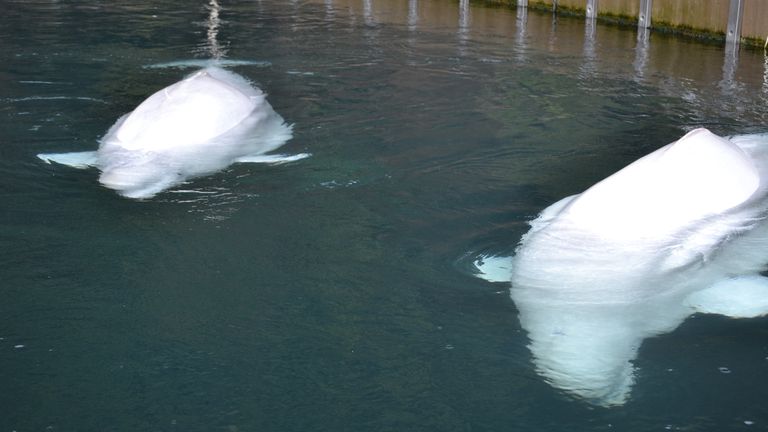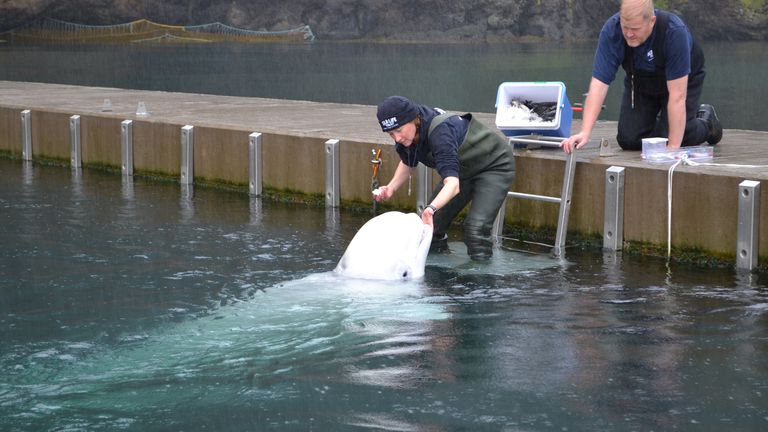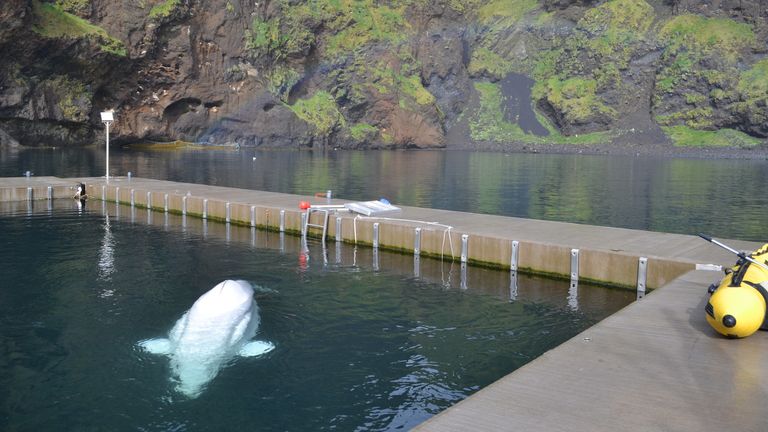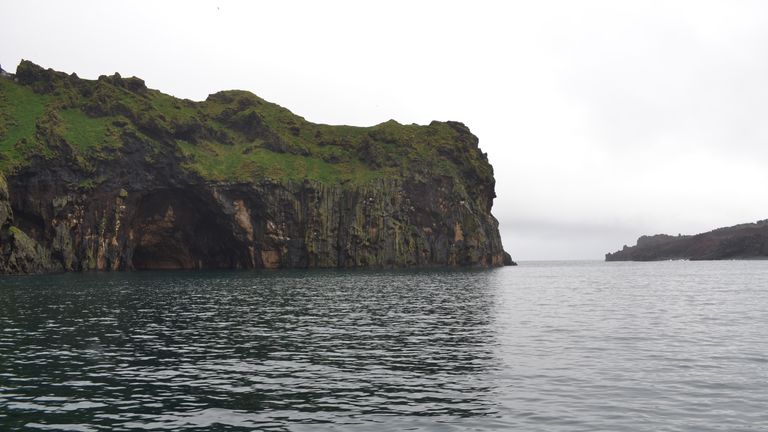As we approach the Westman Islands, the rain is falling in drenching, sweeping clouds. Settled off the south coast of Iceland, they are rugged, beautiful, cold and wet.
Only one island is inhabited by people. It is not a place for the faint-hearted. But it is a good place for whales.
It is the sort of location where nature pushes in on you.
The islands were created and shaped by volcanoes. The weather, the sea, the cliffs and the birds are all celebrated.
As we come to visit, islanders are working together to rescue disorientated baby puffins, called pufflings, who have wandered towards the light of town instead of heading out to sea. They are found, cleaned and then released into the wild.
Pufflings are tiny and fragile. But out in the bay are animals at the other end of the scale - giant and stately. In their own way, they're just as vulnerable.
And that's why we've come all this way - to meet Little Grey and Little White.
The rain slows as we climb on board a motorboat. We approach a bay halfway between the harbour and the open sea and you can see a couple of large pools, divided by pontoons.
And there, breaking the surface of the water, you can see movement - a glimpse of white amid the blue water. Then, gloriously, the sight of a whale; its head appearing out of the water, glancing and then diving down again; its body smoothly cutting out of the waves before gently returning under the surface.
From a distance, they are impressive. Close up, they are extraordinary.
Four metres long but graceful; huge but also lithe. Mischievous and massive.
But, of course, there is something wrong here. These are beluga whales - wild animals that should be roaming the ocean, not being held in captivity.
Yet what we're seeing here is the solution, not the problem.
Little White and Little Grey were captured when they were babies and taken to a Russian research centre. They were then moved to a Chinese aquarium and spent around a decade as entertainment for visitors where they were trained to dance and clap on command.
But the Chinese aquarium was taken over by Merlin Entertainment, a company opposed to keeping whales and dolphins in captivity. A plan was made to return the whales to a natural habitat; to create a sanctuary out here in the Westman Islands.
The process of moving them was as hard as you might imagine - planes, lorries, boats and a lot of planning. A huge cradle had to be made to transport the whales out to the bay; it now hangs over the heads of the volunteers who are cleaning the pufflings.
But the plan worked; the whales made it to the bay and now, as I watch, they glide through the water a few feet away from me.
Jessica Whiton is the beluga curator for the sanctuary.
As we chat, she is also talking to the whales, feeding them, and worrying about them, as they swim around the big open-water "care pools" - the final stop before they are released into the bay itself.
So why not just send these whales off to sea, and wish them well? She tells me: "You can't; you simply can't."
"These guys have spent about 10 years in an aquarium. They don't know how to hunt for themselves, what to hunt or even really that what they're eating is live fish. They've eaten restaurant quality frozen fish almost their entire lives so it's hard for them to learn these things.
"It's like you or me - we think we're pretty smart people - but if you put me up in the north of Iceland, well, I know how I'm supposed to be able to eat, but do I have the tools I need to be able to do that?
"These guys don't have the tools to be able to live in the wild so by having this sanctuary here, we can give them a natural habitat but also see what they learn. Will they work out how to hunt, for instance? We can learn from them, but also give them the care that they had in an aquarium."
Next to us, the whales bump into each other playfully.
We put a waterproof camera into the water to film them, and Little Grey stares straight down the lens before opening an enormous mouth to see if the camera is edible. We pull the camera out of the water just in time.
Around the world, there are more than 300 beluga whales in captivity.
Audrey Padgett moved to Iceland from South Carolina to be general manager of this sanctuary.
"I moved here a little more than a year ago and thought I'd be here for six months but I fell in love with the project and with the two belugas," Ms Padgett said.
"They steal your heart pretty fast."
:: Subscribe to the Daily podcast on Apple Podcasts, Google Podcasts, Spotify, Spreaker
"It's a step forward to show that there is a more natural alternative, especially for belugas who have either been in captivity or who have been raised in captivity. People's attitudes continue to change. People know more and more about these animals - how smart they are, how social they are and I think that inspires people to want to do better for them."
The project has taken a big step forward.
Little Grey and Little White have been released from their pools and given the freedom of the bay.
They cannot swim off to sea but they do have new challenges - rocks, fish and depth changes.
After 10 years in the clear water of an aquarium, this is all new.
For a decade, they didn't feel rain; now they get to swim freely. For a decade, they had to entertain humans; now, away from captivity, they get to revel in their own lives.
"captivity" - Google News
September 28, 2020 at 10:09AM
https://ift.tt/3mUP5ax
Beluga whales enjoy new freedom after years of captivity - but there are still hurdles - Sky News
"captivity" - Google News
https://ift.tt/3b01anN
https://ift.tt/3dbExxU
Bagikan Berita Ini


















0 Response to "Beluga whales enjoy new freedom after years of captivity - but there are still hurdles - Sky News"
Post a Comment